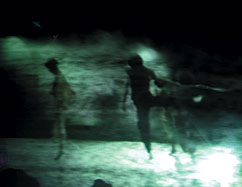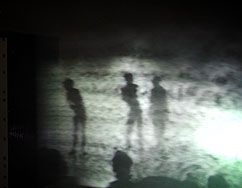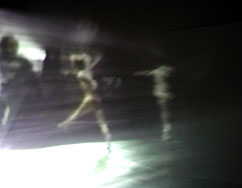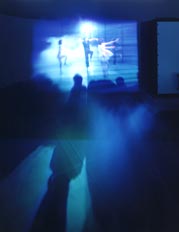 |
| Photo courtesy: Addison Gallery of American Art, Phillips Academy, Andover, MA |
 |
| Photo courtesy: Addison Gallery of American Art, Phillips Academy, Andover, MA |
 |
| Photo courtesy: Addison Gallery of American Art, Phillips Academy, Andover, MA |
 |
| Photo: TAKAYAMA Kozo |
|
|
Nakaya was in charge of the "fog sculpture" at the Pepsi Pavilion, which utilized the fogging nozzle developed by the American cloud physicist Tom Mee. The "Mee nozzle" developed for this work was later experimentally applied to outdoor air conditioning, irrigation, and frost damage prevention in the agricultural and film industries. The artificial fog system was a practical example of E.A.T.'s ideal of the meeting between technology and art.
Nakaya continued to use artificial fog to render visible the interaction of invisible atmospheric flows with particular natural environments. She used this same technology to create a set out of artificial fog for Trisha Brown's dance performance Opal Loop/Cloud Installation #72503. The piece was presented in New York in 1980 and was the second in Brown's series of collaborations with visual artists (the first being her 1979 collaboration with Rauschenberg, Glacial Decoy). "Clouds culminate, tumble down, and dance with the dancers. A surf of fog rolls forward across the stage and the dancers disappear into it. Reaching the audience, the fog is retracted from the stage by reversing the convection. Many techniques of controlling the fog in a closed environment by combining thermodynamic and aerodynamic means as well as the on/off controls of pumps were developed through this project with the assistance of E.A.T." (research and technical assistance by Billy Kl_ver and Jill Krauskopf/E.A.T.) (*). At first, the dancers had trouble because the fog made the stage slippery, but this problem was solved by using heaters to dry the floor.
The current piece is a reconstruction produced for the traveling exhibition (2002-2003) "Trisha Brown: Dance and Art in Dialogue 1961-2001" curated by the Addison Gallery of American Art in Andover, Massachusetts. Images of the original dance performance are projected onto the clouds of fog. As viewers watch the fog billow in the distance, other viewers walk right through the projected images. Many of Brown's "constructed improvisations" were inspired by everyday gestures. The Judson Group in which Brown participated during the sixties, also welcomed painters and sculptors like Rauschenberg, who had no experience or specialized dance training, as dancers and choreographers. The performances of the Judson Group incorporated movements related to everyday objects and actions.
As viewers enter the fog, they find themselves moving about playfully with other viewers, experiencing the same feelings the dancers did when the fog served as a set. At the same time, this unconscious urge to play in the fog brings viewers closer to the source of Brown's choreography. In this video installation of the work, an interactive environment is created where people and fog play randomly among the recorded images projected through the fog and onto the walls. [KAMIKANDA Kei]
* -- See Nakaya's homepage
http://www.nakaya.net/j/index.html(Japanese)
http://www.nakaya.net/e/index.html(English)
|
